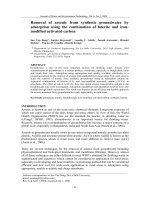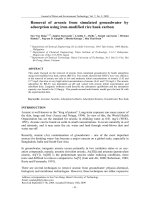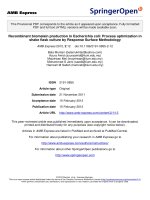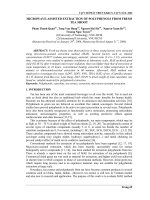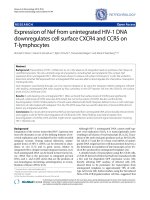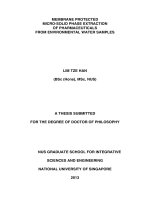EXTRACTION OF ANTHOCYANNIN FROM MUMBERY FRUITS: PROCESS OPTIMIZATION USING RESPONSE SURFACE METHODOLOGY (RSM)
Bạn đang xem bản rút gọn của tài liệu. Xem và tải ngay bản đầy đủ của tài liệu tại đây (433.66 KB, 5 trang )
EXTRACTION OF ANTHOCYANNIN FROM MUMBERY FRUITS: PROCESS
OPTIMIZATION USING RESPONSE SURFACE METHODOLOGY (RSM)
Lưu Thi Lan Anh1, Nguyen Thị Tuyet Mai2*, Tran Thanh Thai3, Trinh Xuan Anh2, Phan Trung
Nghia2, Ta Ngoc Dung2, Huynh Dang Chinh2 and Vo Thach Son1
1
School of Physics Engineering, Hanoi University of Science and Technology, No1, Dai Co Viet,
Hai Ba Trung, Hanoi, Vietnam
2
School of Chemical Engineering, Hanoi University of Science and Technology, No1, Dai Co Viet,
Hai Ba Trung, Hanoi, Vietnam
3
Quy Nhon University, 170, An Duong Vuong Street, Quynhon, Binhdinh
Abstract
The use of anthocyanin as a source of natural dyes has been increased due to its lack of toxicity. In this study,
natural dyes from the mulberry fruits extracted under different operating conditions such as extraction time (20 ÷60 min),
temperature (40÷80 0C) and mass of the mulberry (10 ÷25 g) by conventional extraction technique. Response
surface methodology (RSM) with the help of Design Expert Version 7.1.6 (STAT-EASE Inc., USA) for optimization of the
extraction process and evaluation of interaction effects of different operating parameters. The optimum conditions for dye
extraction were 40 min, 60oC and 17.5 g for extraction time, temperature, and mass of the fruits, respectively. The
efficiency of extraction under these optimum conditions was found 1.147%.
Keywords: Anthocyanin, natural dyes, mulberry, Response surface methodology (RSM)
I. INTRODUCTION
Dye-sensitized solar cells (DSSCs) which are
also called Graetzel cells are a novel type of solar
cells.
Their
advantages
are
mainly low
cost production, low energy payback time,
flexibility, performance also at diffuse light and
multicolored options[1]–[5]. DSSCs become more
and more interesting since a huge variety of dyes
including also natural dyes can be used as light
harvesting elements which provide the charge
carriers. Unlike synthetic dye-sensitizers, natural
ones are easy to prepare, cheap, non-toxic,
environmentally friendly and fully biodegradable.
Among natural pigments, three main families of
compounds have
been
exploited as sensitizer in DSSCs: chlorophylls [6],
[7], anthocyanins [6], [8] and betalains [6]. In this
article we focused our attention only on
anthocyanins. Anthocyanins are a very large group
of red-blue plant pigments, which naturally occurs
in all higher plants. They are responsible for the
coloration of flowers, fruits, fruit juice, wines,
leaves, stems, bulbs, roots, etc. The main sources of
anthocyanins are some vegetables such as
blackberries, grapes, blueberries, eggplant, mango
…
A response surface methodology (RSM) based
on statistical design of experiments (DOEs) is
becoming increasingly widespread in several
sciences such as analytical chemistry, engineering
and environmental. Recently RSM have been used
jointly for both modeling and optimization of nature
dye extraction method [9].
In the present study, anthocyanins from the
mulberry fruits extracts under different operating
conditions such as extraction time (20÷60 min),
temperature (40÷800C) and mass of the mulberry
(10÷25g) by conventional extraction technique.
The RSM with the help of Design Expert Version
7.1.6 (STAT-EASE Inc., USA) use for optimization
of the extraction process and evaluation of
interaction effects of different operating parameters.
II. EXPERIMENTS
Extract of dye
Mulberry fruits were purchased from a local
supermarket in Hanoi, Vietnam. The extracts of
mulberry fruits obtained from fresh fruit. The fruits
cleaned and dried. The first, 20g of fresh mulberry
put
into 60ml of
ethanol
(Merck)
in
glass100ml. Mixture heated to a temperature
extraction for 30 minutes. And then, Solution is
filter more time with ethanol. At last, solution dries
until mass constants. All samples protected from
direct light exposure.
Design of experiment
Anthocyanin extraction parameters obtained
by Mulberry fruits were optimized following the
CCD and RSM. A 5-level-3-factor central composite
design was
employed to evaluate the
extraction parameters in this study. Twenty
experiments were performed in a random order. The
1
choice of given variables and their range were
selected based on several outside sources and on
preliminary studies in our laboratory. The range and
coded level of the anthocyanin extraction process
variables studied are listed in Table 1. Total of 20
experiments were set up using the CCD matrix. The
yield extraction of mulberry values (Y) was
taken as the response of the design experiment.
Design Expert software version 7.0.0 (STAT-EASE
Inc., Minneapolis, USA) was used for regression
analysis of the experimental data and to calculate
the effect of each variable and mutual effect. The
responses (Y) of the anthocyanin extraction
process were used to develop a quadratic
polynomial equation that correlates the values of
yield extraction as a function of the independent
variables and their interactions as shown in the
following Eq. (1):
(1)
where Hdye is the anthocyanin extraction yield
value in mulberry fruit, β0 is the offset term, β i is the
linear effect, βii is the squared effect, βij is the
interaction effect, xi is the ith independent variable
and xj is the jth independent variable. The
developed model was tested with the analysis of
variance (ANOVA) with 5% level of significance.
The statistical significance of the second-order
model equation was determined by F-value. Plotting
of response surfaces and contour plots were used to
identify the optimum conditions of the extraction
parameters.
Table 1. Independent variables and levels used for response surface design
Independent
variables
Temperature
Weight
Time
Units
0
C
gram
min
III. RESULTS AND DISCUSSION
The model expressed by Eq. (2) represents the
anthocyanin extraction yield value in mulberry fruit
(Hdye) as a function of temperature (A), weight (B) and
extraction time (C):
Hdye = 1.10 + 0.22*A + 0.19*B + 0.17*C - 0.15* A2
- 0.17*B2 - 0.19*C2
Range of factors
Min
Max
A
40
80
B
10
25
C
20
60
are not significant. As shown in Table 3, the model
is a good significant with F-value of 1.14, and a
sufficient probability value (0.0006). The lack of fit
value (F-value: 2.03) for regression of Eq. (2) is not
significant. Non-significant lack of fit is good and
displays that the model equation was sufficient for
predicting the yield extraction of the samples. The
effects of the extraction parameters such as
temperature, weight and extraction time were
investigated on the yield values. The P- values show
the significance of coefficients and are also
important for understanding the relationship between
the parameters. According to the analysis of variance
(Table 2) A (temperature), B (weigh) and C
(extraction time) are the most significant parameters
(Prob > F less).
Symbol
(2)
The statistical significance of Eq. (2) was
controlled by F-test and the analysis of variance
(ANOVA) for response surface quadratic model is
given in Table 2. Values of probability (P) > F less
than 0.05 indicate that model terms are significant.
Values greater than 0.1000 indicate the model terms
Table 2. Analysis of variance (ANOVA) for the fitted quadratic polynomial model
for optimization of mulberry fruit extraction parameters
P -Value
Source
Sum of Squares
Df
Mean Square
F - Value
Prob > F
Model
0.88
9
0.098
10.14
0.0006
A-Temperature
0.052
1
0.052
5.39
0.0427
B-Weigh
0.021
1
0.021
2.14
0.173
C-Time
0.038
1
0.038
3.91
0.0761
AB
1.426E-003
1
1.426E-003
0.15
0.7087
AC
5.073E-003
1
5.073E-003
0.53
0.4850
BC
3.200E-005
1
3.200E-005
3.316E-003
0.9552
A2
0.015
1
0.015
1.50
0.2482
B2
5.982E-003
1
5.982E-003
0.62
0.4493
C2
7.164E-003
1
7.164E-003
0.74
0.4091
Residual
0.097
10
9.650E-003
2
Lack of Fit
Pure error
Cor Total
0.092
5.000E-003
0.98
9
1
19
The 3D response surfaces and 2D contour
plots (Fig. 1, 2 and 3) generated by Design Expert
0.010
5.000E-003
2.03
0.4991
software version 7.0.0 are the graphical
representations of the regression equation.
Yield
(a)
(b)
Weight
Yield
Yield
Weight
Temp.
Temp.
Fig.1.3D response surfaces (a) and 2D contour plots (b) showing the effects of
weight and temperature when extraction time was at 40min
Yield
Time
Yield
Yield
Time
Temp.
Temp.
Fig.2. 3D response surfaces (a) and 2D contour plots (b) showing the effects of extraction time
and temperature when weight was at 17.5g
Yield
Time
Yield
Yield
Time
Weight
Weight
Fig.3. 3D response surfaces (a) and 2D contour plots (b) showing the effects of weight
and extraction time when temperature was at 600C
They can visualize the relationship between the
response and each variable, and the interactions
between two tested variables. The 3D response
surfaces and their respective 2D contours can also
find the optimum ranges of the variables for
the maximum of the response. The maximum
predicted response indicated by the surface
confined in the smallest ellipse in the contour
diagram.
On the basis of medium optimization, the
quadratic model predicted that the maximum yield
was 1.15%, when the temperature was 600C, weight
was 17.5g and extraction time was 40min,
respectively. To verify the predicted results,
3
validation experiments were performed in triplicate.
Under the optimized condition, the observed
experimental extraction yield was 1.147%,
suggesting that experimental and predicted values
(1.15%) were in good agreement.
3. N. a. Ludin, a. M. Al-Alwani Mahmoud, A.
Bakar Mohamad, A. A. H. Kadhum, K. Sopian,
and N. S. Abdul Karim, Renew. Sustain. Energy
Rev., vol. 31, 2014, pp. 386-396.
IV. CONCLUSION
4. M. R. Narayan, Renew. Sustain. Energy Rev., vol.
16, no. 1, 2011, pp. 208-215.
This study proved that statistical experimental
designs offer an efficient extraction yield
optimization of mulberry fruits. A maximum
extraction yield of 1.15% was achieved with the
following optimized factors: the temperature 600C,
weight 17.5g and extraction time 40min. Under the
optimized conditions, extraction yield of mulberry
fruits was1.15%. Validation experiments were also
carried out to verify the accuracy of the model, and
results showed that the predicted value agreed well
with the experimental values.
REFERENCES
1. C.-Y. Chien and B.-D. Hsu, Sol. Energy, vol. 98,
2013, pp. 203-211.
2. N. Asim, K. Sopian, S. Ahmadi, K. Saeedfar, M.
A. Alghoul, O. Saadatian, and S. H. Zaidi,
Renew. Sustain. Energy Rev., vol. 16, no. 8,
2012, pp. 58345847.
5. J. Gong, J. Liang, and K. Sumathy, Renew. Sustain.
Energy Rev., vol. 16, no. 8, 2012, pp. 5848-5860.
6. M. Shahid and F. Mohammad, J. Clean. Prod.,
vol. 53, 2013, pp. 310-331.
7. G. Calogero, I. Citro, G. Di Marco, S. Armeli
Minicante, M. Morabito, and G. Genovese,
Spectrochim. Acta. A. Mol. Biomol. Spectrosc.,
vol. 117, 2014, pp. 702-6.
8. G. Calogero, J.-H. Yum, A. Sinopoli, G. Di
Marco, M. Grätzel, and M. K. Nazeeruddin, Sol.
Energy, vol. 86, no. 5, 2012, pp. 1563-1575.
9. K. Sinha, S. Chowdhury, P. Das Saha, and S. Datta,
Ind. Crops Prod., vol. 41, 2013, pp. 165-171.
4
QUÁ TRÌNH CHIẾT CHẤT ANTHOCYANIN TỪ QUẢ DÂU TẰM: TỐI ƯU
HÓA QUÁ TRÌNH CHIẾT SỬ DỤNG PHƯƠNG PHÁP BỀ MẶT ĐÁP ỨNG
(RSM)
Lưu Thị Lan Anh1, Nguyễn Thị Tuyết Mai2*, Trần Thanh Thái3, Trịnh Xuân Anh2, Phan Trung
Nghĩa2, Tạ Ngọc Dũng2, Huỳnh Đăng Chính2, and Võ Thạch Sơn1
1
Viện Vật lý Kỹ thuật, Trường Đại học Bách khoa Hà Nội, Số 1 Đại Cồ Việt Hà Nội, Việt Nam
Viện Kỹ thuật Hóa học, Trường Đại học Bách khoa Hà Nội Số 1 Đại Cồ Việt Hà Nội, Việt Nam
3
Đại học Quy Nhơn, 170 An Dương Vương, Quy Nhơn, Bình Định
2
Tóm tắt
Anthocyanin thường được sử dụng như nguồn chất màu tự nhiên ngày càng gia tăng do chất này không độc.
Trong nghiên cứu này, chúng tôi đã khảo sát sự chiết chất màu tự nhiên từ quả dâu tằm trong các điều kiện khác
nhau như thời gian chiết (20÷60 phút), nhiệt độ chiết (40÷80 0C) và khối lượng dâu tằm sử dụng (10÷25 g). Phương
pháp bề mặt đáp ứng (RSM) với sự trợ giúp của phần mềm Design Expert Version 7.1.6 (STAT-EASE Inc., USA) để
mô phỏng và tối ưu hóa quá trình chiết theo các thông số nghiên cứu. Điều kiện chiết chất màu anthocyanin tối ưu
nhất theo mô phỏng là: Thời gian chiết t = 40 phút, nhiệt độ chiết T = 60 oC and và khối lượng dâu tằm chiết m =
17.5 g. Hiệu suất chiết tối ưu đạt được là H = 1.15%. Giá trị này phù hợp với giá trị thực nghiệm H = 1.147%.
Từ khóa: Anthocyanin, chất màu tự nhiên, dâu tằm, phương pháp bề mặt đáp ứng (RSM)

